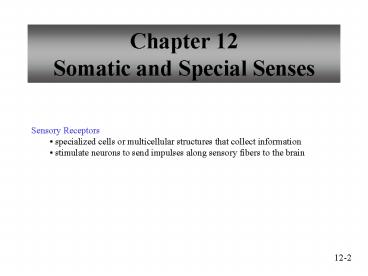Chapter 12 Somatic and Special Senses - PowerPoint PPT Presentation
Title:
Chapter 12 Somatic and Special Senses
Description:
Title: PowerPoint to accompany Author: Ryan&Regina Hoffman Last modified by: User Created Date: 1/14/2003 10:34:08 PM Document presentation format – PowerPoint PPT presentation
Number of Views:99
Avg rating:3.0/5.0
Title: Chapter 12 Somatic and Special Senses
1
Chapter 12Somatic and Special Senses
- Sensory Receptors
- specialized cells or multicellular structures
that collect information - stimulate neurons to send impulses along sensory
fibers to the brain
12-2
2
Receptor Types
- Chemoreceptors
- respond to changes in chemical concentrations
- Pain receptors
- respond to tissue damage
- Thermoreceptors
- respond to changes in temperature
- Mechanoreceptors
- respond to mechanical forces
- Photoreceptors
- respond to light
12-3
3
Sensory Impulses
- stimulation of receptor causes local change in
its membrane - a graded electrical current is generated that
reflects intensity of stimulation - if receptor is part of a neuron, the membrane
potential may generate an action potential - if receptor is not part of a neuron, the
receptor potential must be transferred to a
neuron to trigger an actin potential - peripheral nerves transmit impulses to CNS
- Sensation
- feeling that occurs when brain interprets
sensory impulse
12-4
4
Sensory Adaptation
- adjustment of sensory receptors from continuous
stimulation - stronger stimulus required to activate receptors
- smell receptors undergo sensory adaptation
12-1
5
Somatic Senses
- senses associated with skin, muscles, joints,
and viscera
- three groups
- exteroceptive senses senses associated with
body surface touch, pressure, temperature, pain - proprioceptive senses senses associated with
changes in muscles and tendons - visceroceptive senses senses associated with
changes in viscera
12-6
6
Touch and Pressure Senses
- Free nerve endings
- common in epithelial tissues
- detect touch and pressure
- Meissners corpuscles
- abundant in hairless portions of skin
- detect light touch
- Pacinian corpuscles
- common in deeper subcutaneous tissues, tendons,
and ligaments - detect heavy pressure
12-7
7
Touch and Pressure Senses
12-8
8
Temperature Senses
- Warm receptors
- sensitive to temperatures above 25oC (77o F)
- unresponsive to temperature above 45oC (113oF)
- Cold receptors
- sensitive to temperature between 10oC (50oF) and
20oC (68oF)
- Pain receptors
- respond to temperatures below 10oC
- respond to temperatures above 45oC
12-9
9
Sense of Pain
- free nerve endings
- widely distributed
- nervous tissue of brain lacks pain receptors
- stimulated by tissue damage, chemical,
mechanical forces, or extremes in temperature - do not adapt
- Visceral Pain
- may exhibit referred pain
- not well localized
12-10
10
Referred Pain
- may occur due to sensory impulses from two
regions following a common nerve pathway to brain
12-11
11
Pain Nerve Fibers
- Chronic pain fibers
- thin, unmyelinated
- conduct impulses more slowly
- associated with dull, aching pain
- difficult to pinpoint
- Acute pain fibers
- thin, myelinated
- conduct impulses rapidly
- associated with sharp pain
- well localized
12-12
12
Regulation of Pain Impulses
- Thalamus
- allows person to be aware of pain
- Pain Inhibiting Substances
- enkephalins
- serotonin
- endorphins
- Cerebral Cortex
- judges intensity of pain
- locates source or pain
- produces motor response to pain
- produces emotions to pain
12-13
13
Stretch Receptors
- proprioceptors
- send information to CNS concerning lengths and
tensions of muscles - 2 main kinds of stretch receptors
- muscle spindles in skeletal muscles
- Golgi tendon organs in tendons
12-14
14
Stretch Receptors
12-15
15
Special Senses
- sensory receptors are within large, complex
sensory organs in the head - smell in olfactory organs
- taste in taste buds
- hearing and equilibrium in ears
- sight in eyes
12-16































